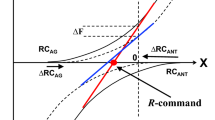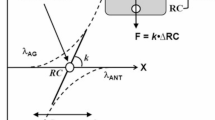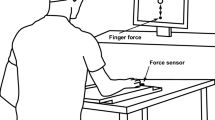Abstract
We explored changes in finger forces and in an index of unintentional finger force production (enslaving) under a variety of visual feedback conditions and positional finger perturbations. In particular, we tested a hypothesis that enslaving would show a consistent increase with time at characteristic times of about 1–2 s. Young healthy subjects performed accurate force production tasks under visual feedback on the total force of the instructed fingers (index and ring) or enslaved fingers (middle and little). Finger feedback was covertly alternated between master and enslaved fingers in a random fashion. The feedback could be presented over the first 5 s of the trial only or over the whole trial duration (21 s). After 5 s, the fingers were lifted by 1 cm, and after 15 s, the fingers were lowered to the initial position. The force of the instructed fingers drifted toward lower magnitudes in all conditions except the one with continuous feedback on that force. The force of enslaved fingers showed variable behavior across conditions. In all conditions, the index of enslaving showed a consistent increase with the time constant varying between 1 and 3 s. We interpret the results as pointing at the spread of excitation to enslaved fingers (possibly, in the cortical M1 areas). The relatively fast changes in enslaving under positional finger perturbations suggest that quick changes of the input into M1 from pre-M1 areas can accelerate the hypothesized spread of cortical excitation.





Similar content being viewed by others
Data availability statement
The original data are available from the corresponding author at a reasonable request.
References
Abolins V, Stremoukhov A, Walter C, Latash ML (2020) On the origin of finger enslaving: Control with referent coordinates and effects of visual feedback. J Neurophysiol 124:1625–1636
Ambike S, Zatsiorsky VM, Latash ML (2015) Processes underlying unintentional finger force changes in the absence of visual feedback. Exp Brain Res 233:711–721
Ambike S, Mattos D, Zatsiorsky VM, Latash ML (2016) Unsteady steady-states: Central causes of unintentional force drift. Exp Brain Res 234:3597–3611
An KN, Chao EY, Cooney WP, Linscheid RL (1985) Forces in the normal and abnormal hand. J Orthop Res 3:202–211
Brandauer B, Hermsdörfer J, Geissendörfer T, Schoch B, Gizewski ER, Timmann D (2012) Impaired and preserved aspects of independent finger control in patients with cerebellar damage. J Neurophysiol 107:1080–1093
Bullimore SR, Leonard TR, Rassier D, Herzog W (2007) History dependence of isometric muscle force: effect of prior stretch or shortening amplitude. J Biomech 40:1518–1524
Chao EY, Opgrande JD, Axmear FE (1976) Three-dimensional force analysis of finger joints in selected isometric hand functions. J Biomech 9:387–396
Cuadra C, Falaki A, Sainburg RL, Sarlegna FR, Latash ML (2019) Case studies in neuroscience. The central and somatosensory contributions to finger inter-dependence and coordination: Lessons from a study of a “deafferented person.” J Neurophysiol 121:2083–2087
Cuadra C, Wojnicz W, Kozinc Z, Latash ML (2020) Perceptual and motor effects of muscle co-activation in a force production task. Neurosci 437:34–44
Danion F, Schöner G, Latash ML, Li S, Scholz JP, Zatsiorsky VM (2003) A force mode hypothesis for finger interaction during multi-finger force production tasks. Biol Cybern 88:91–98
Feldman AG (2015) Referent control of action and perception: Challenging conventional theories in behavioral science. Springer, NY
Herzog W, Leonard TR (2000) The history dependence of force production in mammalian skeletal muscle following stretch-shortening and shortening-stretch cycles. J Biomech 33:531–542
Hirose J, Cuadra C, Walter C, Latash ML (2020) On the origin of unintentional force drifts and finger interdependence. Hum Move Sci 74:102714
Ilmane N, Sangani S, Feldman AG (2013) Corticospinal control strategies underlying voluntary and involuntary wrist movements. Behav Brain Res 236:350–358
Jo HJ, Ambike S, Lewis MM, Huang X, Latash ML (2016) Finger force changes in the absence of visual feedback in patients with Parkinson’s disease. Clin Neurophysiol 127:684–692
Kapur S, Zatsiorsky VM, Latash ML (2010) Age-related changes in the control of finger force vectors. J Appl Physiol 109:1827–1841
Keen DA, Fuglevand AJ (2004) Common input to motor neurons innervating the same and different compartments of the human extensor digitorum muscle. J Neurophysiol 91:57–62
Kilbreath SL, Gandevia SC (1994) Limited independent flexion of the thumb and fingers in human subjects. J Physiol 479:487–497
Kim SW, Shim JK, Zatsiorsky VM, Latash ML (2008) Finger interdependence: Linking the kinetic and kinematic variables. Hum Move Sci 27:408–422
Landsmeer JMF, Long C (1965) The mechanism of finger control, based on electromyograms and location analysis. Acta Anat 60:330–347
Lang CE, Schieber MH (2003) Differential impairment of individuated finger movements in humans after damage to the motor cortex or the corticospinal tract. J Neurophysiol 90:1160–1170
Latash ML (2008) Synergy. Oxford University Press, New York
Latash ML (2016) Towards physics of neural processes and behavior. Neurosci Biobehav Rev 69:136–146
Latash ML (2019) Physics of Biological Action and Perception. Academic Press, New York, NY
Latash ML, Huang X (2015) Neural control of movement stability: Lessons from studies of neurological patients. Neurosci 301:39–48
Latash ML, Li S, Danion F (2002) Zatsiorsky VM (2002) Central mechanisms of finger interaction during one- and two-hand force production at distal and proximal phalanges. Brain Res 924:198–208
Latash ML, Scholz JF, Danion F, Schöner G (2001) Structure of motor variability in marginally redundant multi-finger force production tasks. Exp Brain Res 141:153–165
Latash ML, Scholz JP, Schöner G (2007) Toward a new theory of motor synergies. Mot Control 11:276–308
Latash ML, Shim JK, Smilga AV, Zatsiorsky V (2005) A central back-coupling hypothesis on the organization of motor synergies: a physical metaphor and a neural model. Biol Cybern 92:186–191
Latash ML, Zatsiorsky VM (1993) Joint stiffness: Myth or reality? Hum Move Sci 12:653–692
Li S, Latash ML, Yue GH, Siemionow V, Sahgal V (2003) The effects of stroke and age on finger interaction in multi-finger force production tasks. Clin Neurophysiol 114:1646–1655
Li ZM, Latash ML, Zatsiorsky VM (1998) Force sharing among fingers as a model of the redundancy problem. Exp Brain Res 119:276–286
Long C (1965) Intrinsic-extrinsic muscle control of the fingers. J Bone Jt Surg 50A:973–984
Martin V, Scholz JP, Schöner G (2009) Redundancy, self-motion, and motor control. Neural Comput 21:1371–1414
McIsaac TL, Fuglevand AJ (2007) Motor-unit synchrony within and across compartments of the human flexor digitorum superficialis. J Neurophysiol 97:550–556
Mirakhorlo M, Maas H, Veeger HEJ (2018) Increased enslaving in elderly is associated with changes in neural control of the extrinsic finger muscles. Exp Brain Res 236:1583–1592
Park J, Wu Y-H, Lewis MM, Huang X, Latash ML (2012) Changes in multi-finger interaction and coordination in Parkinson’s disease. J Neurophysiol 108:915–924
Parsa B, O’Shea DJ, Zatsiorsky VM, Latash ML (2016) On the nature of unintentional action: A study of force/moment drifts during multi-finger tasks. J Neurophysiol 116:698–708
Raptis H, Burtet L, Forget R, Feldman AG (2010) Control of wrist position and muscle relaxation by shifting spatial frames of reference for motoneuronal recruitment: possible involvement of corticospinal pathways. J Physiol 588:1551–1570
Rasouli O, Solnik S, Furmanek MP, Piscitelli D, Falaki A, Latash ML (2017) Unintentional drifts during quiet stance and voluntary body sway. Exp Brain Res 235:2301–2316
Rearick MP, Casares A, Santello M (2003) Task-dependent modulation of multi-digit force coordination patterns. J Neurophysiol 89:1317–1326
Reilly KT, Nordstrom MA, Schieber MH (2004) Short-term synchronization between motor units in different functional subdivisions of the human flexor digitorum profundus muscle. J Neurophysiol 92:734–742
Reilly KT, Schieber MH (2003) Incomplete functional subdivision of the human multitendoned finger muscle flexor digitorum profundus: an electromyographic study. J Neurophysiol 90:2560–2570
Reschechtko S, Latash ML (2017) Stability of hand force production: I. Hand level control variables and multi-finger synergies. J Neurophysiol 118:3152–3164
Reschechtko S, Zatsiorsky VM, Latash ML (2014) Stability of multi-finger action in different spaces. J Neurophysiol 112:3209–3218
Schieber MH (2001) Constraints on somatotopic organization in the primary motor cortex. J Neurophysiol 86:2125–2143
Schieber MH, Santello M (2004) Hand function: peripheral and central constraints on performance. J Appl Physiol 96:2293–2300
Scholz JP, Schöner G (1999) The uncontrolled manifold concept: Identifying control variables for a functional task. Exp Brain Res 126:289–306
Shinohara M, Latash ML, Zatsiorsky VM (2003) Age effects on force produced by intrinsic and extrinsic hand muscles and finger interaction during MVC tasks. J Appl Physiol 95:1361–1369
Slifkin AB, Vaillancourt DE, Newell KM (2000) Intermittency in the control of continuous force production. J Neurophysiol 84:1708–2171
Slobounov S, Chiang H, Johnston J, Ray W (2002) Modulated cortical control of individual fingers in experienced musicians: an EEG study Electroencephalographic study. Clin Neurophysiol 113:2013–2024
Solnik S, Qiao M, Latash ML (2017) Effects of visual feedback and memory on unintentional drifts in performance during finger pressing tasks. Exp Brain Res 235:1149–1162
van Beek N, Stegeman DF, Jonkers I, de Korte CL, Veeger D, Maas H (2019) Single finger movements in the aging hand: changes in finger independence, muscle activation patterns and tendon displacement in older adults. Exp Brain Res 237:1141–1154
van Duinen H, Gandevia SC (2011) Constraints for control of the human hand. J Physiol 589:5583–5593
Vaillancourt DE, Russell DM (2002) Temporal capacity of short-term visuomotor memory in continuous force production. Exp Brain Res 145:275–285
Wilhelm L, Zatsiorsky VM, Latash ML (2013) Equifinality and its violations in a redundant system: Multi-finger accurate force production. J Neurophysiol 110:1965–1973
Wu Y-H, Pazin N, Zatsiorsky VM, Latash ML (2012) Practicing elements vs. practicing coordination: Changes in the structure of variance. J Motor Behav 44:471–478
Wu Y-H, Pazin N, Zatsiorsky VM, Latash ML (2013) Improving finger coordination in young and elderly persons. Exp Brain Res 226:273–283
Zatsiorsky VM, Li ZM, Latash ML (1998) Coordinated force production in multi-finger tasks: Finger interaction and neural network modeling. Biol Cybern 79:139–150
Zatsiorsky VM, Li ZM, Latash ML (2000) Enslaving effects in multi-finger force production. Exp Brain Res 131:187–195
Zatsiorsky VM, Prilutsky BI (2012) Biomechanics of Skeletal Muscles. Human Kinetics, Champaign, IL
Zhou T, Solnik S, Wu Y-H, Latash ML (2014) Unintentional movements produced by back-coupling between the actual and referent body configurations: Violations of equifinality in multi-joint positional tasks. Exp Brain Res 232:3847–3859
Zhou T, Zhang L, Latash ML (2015) Intentional and unintentional multi-joint movements: Their nature and structure of variance. Neurosci 289:181–193
Author information
Authors and Affiliations
Corresponding author
Ethics declarations
Conflict of interest
No conflict of interest is claimed by any of the authors.
Additional information
Communicated by Francesco Lacquaniti.
Publisher's Note
Springer Nature remains neutral with regard to jurisdictional claims in published maps and institutional affiliations.
Rights and permissions
About this article
Cite this article
Ricotta, J., Cuadra, C., Evans, J.S. et al. Perturbation-induced fast drifts in finger enslaving. Exp Brain Res 239, 891–902 (2021). https://doi.org/10.1007/s00221-020-06027-y
Received:
Accepted:
Published:
Issue Date:
DOI: https://doi.org/10.1007/s00221-020-06027-y




